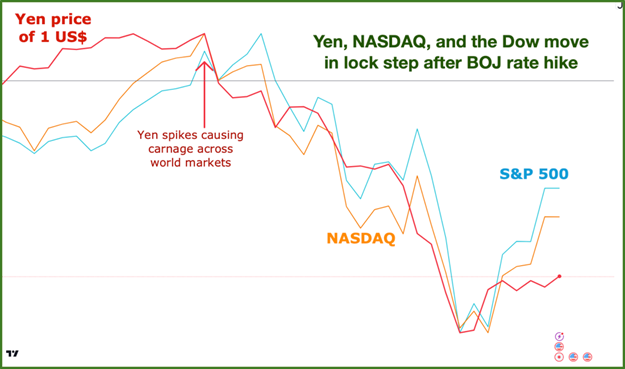Batten the Hatches, This Storm May Not Be Over
 |
| By Juan Villaverde |
The markets regained some composure this week after last week's turbulence triggered by the yen carry trade unwind.
But the pressing question remains: Are we in the eye of the storm, or has the worst already passed?
Let's be honest: No one truly knows, despite the confident claims of market pundits.
The "perma bears" are already proclaiming that the sky is falling, predicting more pain ahead. Meanwhile, the eternal optimists dismiss the recent volatility as nothing more than a temporary blip in an otherwise healthy market.
As usual, the truth likely lies somewhere in the middle.
Last week’s crash wasn’t the result of crumbling economic fundamentals, contrary to what the bears might want you to believe. Instead, it was a technical sell-off sparked by an aggressive — and arguably reckless — attempt by the Japanese government to strengthen the yen.
By early July, Japanese authorities had succeeded … a little too well.
The yen began to appreciate rapidly against the U.S. dollar on July 10. This sharp move ignited a chain reaction, triggering a risk unwind across global markets.
The tech-heavy Nasdaq, a favorite among yen-carry traders, peaked the very same day the yen started its ascent. The broader S&P 500 and Dow Jones indices followed suit shortly after.

There’s been some skepticism about whether the yen’s surge was truly the catalyst for last week’s crash. Let me dispel that notion with the following observation:
Just observe the price paths of the S&P 500, Nasdaq and USD/JPY over the past month: After the carry trade begins to unwind, they cluster together so closely in their descent; you can barely tell them apart.
Normally, the yen-dollar exchange rate has little correlation with U.S. stock indices or other risk assets. But when volatility in that currency pair spikes, as it did last week, it can trigger a broad liquidation event across multiple asset classes.
That’s exactly what we saw.
So, what about this week? The most insightful comment I came across comes from Michael Howell of Capital Wars:
We stay upbeat. But there must be dead bodies buried in the rubble of last week’s currency volatility. Swings in currencies matter.
I couldn’t agree more. The global macroeconomic landscape remains relatively optimistic, and we even saw a spike in global liquidity following last week’s crash.
This is a bullish signal for crypto markets, suggesting they could benefit from the increased liquidity. However, it would be naive to think that last week’s event left no casualties.
Somewhere beneath the surface, there are likely "skeletons" waiting to be uncovered. Should these hidden risks emerge, we could see another leg down in the sell-off that began last week.
Crypto markets got hit hard during the initial turmoil. And they probably won’t be spared if it turns out that we’re still in the eye of the storm.
For now, the best course of action is to stay alert. The market may have stabilized, but the underlying risks have not entirely disappeared.
And if you need a break from this high-volatility environment, there’s another opportunity you should be aware of. One less susceptible to the market’s swings.
My colleague and startup investing specialist, Chris Graebe, has found an out-of-this-world opportunity.
And that I mean that literally!
Chris looked to the stars and found a company using tech so far advanced, Elon Musk could see his entire space empire destroyed overnight.
In fact, McKinsey & Co. values this opportunity at over $1.4 trillion.
And very soon, Weiss Members like you can claim an early stake in the company supercharging this trend … BEFORE it ever goes public.
Just click here to learn more.
Best,
Juan Villaverde

